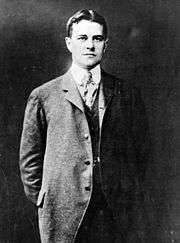Albert Payson Terhune
| Albert Payson Terhune | |
|---|---|
|
Library of Congress 1890–1910 | |
| Born |
December 21, 1872 Newark, New Jersey |
| Died |
February 18, 1942 (aged 69) Pompton Lakes, New Jersey |
| Resting place | Pompton Reformed Church |
| Education | Columbia University |
| Occupation | Writer |
| Known for |
Author Sunnybank Kennels |
| Spouse(s) |
Lorraine Bryson Anice Terhune |
| Children | Lorraine Virginia Terhune Stevens (1898–1956) |
| Parent(s) |
Edward Payson Terhune Mary Virginia Hawes |
| Relatives |
Christine Terhune Herrick (1859–1944), sister Virginia Terhune Van De Water (1865–1945), sister |
| Signature | |
|
| |
Albert Payson Terhune (December 21, 1872 – February 18, 1942) was an American author, dog breeder, and journalist. The public knows him best for his novels relating the adventures of his beloved collies and as a breeder of collies at his Sunnybank Kennels, the lines of which still exist in today's Rough Collies.[1][2]
As a tribute to Terhune, the dog in A Boy and His Dog calls his master Albert. The 1969 novella was written by Harlan Ellison. The 1975 film was directed by L.Q. Jones.
Biography
Albert Payson Terhune was born in New Jersey to Mary Virginia Hawes and the Reverend Edward Payson Terhune. His mother, Mary Virginia Hawes, was a writer of household management books and pre-Civil War novels under the name Marion Harland. Terhune had four sisters and one brother, though only two of his sisters lived to be adults: Christine Terhune Herrick (1859–1944); and Virginia Terhune Van De Water (1865–1945).
Sunnybank (41°00′04″N 74°16′32″W / 41.0012°N 74.2755°W) was originally the family's summer home, with Terhune making it his permanent residence in 1912. He was educated at Columbia University where he received a Bachelor of Arts degree in 1893. From 1894 to 1914, he worked as a reporter for The Evening World.
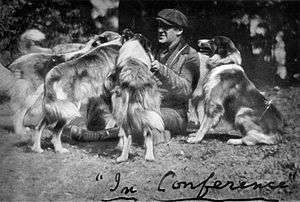
He boxed exhibition matches with James J. Corbett, Bob Fitzsimmons and James J. Jeffries.[3]
His Sunnybank Kennels where he bred and raised rough collies were "the most famed collie kennels in the U.S."[3]
"Bert" Terhune was an active member of the Adventurers' Club of New York.
Terhune was married twice. His first wife, Lorraine Bryson Terhune, died at the age of 23, four days after giving birth to Lorraine Virginia Terhune Stevens (1898–1956) and nine months into the marriage. He later remarried to Anice Terhune; they never had children. He died on February 18, 1942.[1] He was buried at the Pompton Reformed Church in Pompton Lakes, New Jersey.
Legacy
His estate, Sunnybank, in Wayne, New Jersey is maintained as Terhune Memorial Park – Sunnybank.[4][5] It is open to the public and visitors can visit the graves of many of the dogs mentioned in Terhune's works and view a collection of Terhune's book and dog awards at the Van Riper-Hopper Historic House Museum. Historical and family items from the Terhune home, "The Place," can be found at the Pompton Lakes Historical Museum and the Van Riper-Hopper House Museum in Wayne, New Jersey.
Writing
Albert Payson Terhune first published short stories about his collie Lad, titled Lad Stories, in various general-interest magazines, including Red Book, Saturday Evening Post, Ladies' Home Journal, Hartford Courant, and the Atlantic Monthly.[6][7] The first of his novels about his dogs, Lad: A Dog, collected a dozen stories of his collie Lad in novel form. Lad was followed by over 30 additional dog-focused novels, including two additional books about Lad. Published in 1919, the novel was a best seller in both the adult and young adult markets and has been reprinted over 80 times. It was adapted into a feature film in 1962.[8] A man of his time, Terhune is now often criticized by some for his starkly racist depictions of the minorities, hill people and so-called "half-breeds" that peopled parts of northern New Jersey less idealized than Sunnybank.[Since anyone who has read even one of the stories knows that the place is Sunnybank, and not "Sunnybrook," would seem their concern about...racism? is based on here-say only][9][10]
List of works
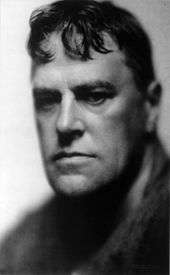
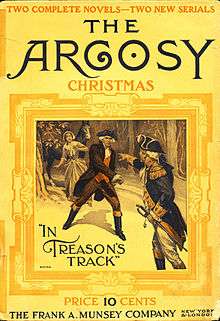
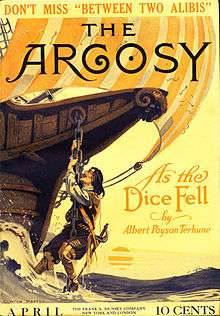
- Syria from the Saddle (1896)
- Columbia Stories (1897)
- How to Box to Win (1900) (written as "Terry McGovern")
- Dr. Dale: A Story Without a Moral (1900) (with Marion Harland)
- The New Mayor (1907)
- Caleb Conover, Railroader (1907)
- The World's Great Events (1908)
- The Fighter (1909)
- The Return of Peter Grimm (1912, novelization of the play by David Belasco)
- The Woman (1912)
- Famous American Indians (1912)
- Around the World in Thirty Days (1914)
- Dad (1914) (with Sinclair Lewis)
- The Story of Damon and Pythias (1915)
- Superwomen (1916) Republished as: Famous Hussies of History (1943)
- Dollars and Cents (1917)
- The Years of the Locust (1917)
- Fortune (1918)
- Wonder Women In History (1918)
- Lad: A Dog (1919)
- Bruce (1920)
- Buff: A Collie (1921)
- The Man in the Dark (1921)
- His Dog (1922)
- Black Gold (1922)
- Black Caesar's Clan (1922)
- Further Adventures of Lad (1922) Republished as: Dog Stories Every Child Should Know (1941)
- The Pest (1923)
- Lochinvar Luck (1923)
- The Amateur Inn (1923)
- Treve (1924)
- The Tiger's Claw (1924)
- The Heart of a Dog (1924)
- Now That I'm Fifty (1925)
- The Runaway Bag (1925)
- Wolf (1925)
- Najib (1925)
- Treasure (1926) Republished as: The Faith of a Collie (1949)
- My Friend the Dog (1926)
- Gray Dawn (1927)
- The Luck of the Laird (1927) Republished as: A Highland Collie (1950)
- Bumps (1927)
- Blundell's Last Guest (1927)
- Water! (1928)
- Black Wings (1928)
- The Secret of Sea-Dream House (1929)
- Lad of Sunnybank (1929)
- To the Best of My Memory (1930)
- Diana Thorne's Dog Basket: A Series of Etchings (1930)
- Proving Nothing (1930)
- A Dog Named Chips (1931)
- The Son of God (1932)
- The Dog Book (1932)
- The Way of a Dog (1932)
- Letters of Marque (1934)
- The Book of Sunnybank (1934) Republished as: Sunnybank: Home of Lad (1953)
- Real Tales of Real Dogs (1935)
- True Dog Stories (1936)
- The Critter and Other Dogs (1936)
- Unseen! (1937)
- The Terhune Omnibus (1937) Republished as The Best-Loved Dog Stories of Albert Payson Terhune (1954)
- A Book of Famous Dogs (1937) Republished as: Famous Dog Stories Every Child Should Know (1937)
- Grudge Mountain (1939) Republished as: Dog of the High Sierras (1951)
- Dogs (1940)
- Loot! (1940) Republished as: Collie to the Rescue (1952)
- Across the Line (1945) (with notes and commentary by Anice Terhune)
- Wallace: Glasgow's Immortal Fire Dog (1961)
- Great Dog Stories (1994) Collects five stories from The Heart of a Dog and five from My Friend the Dog
References
- 1 2 "Albert P. Terhune Dies". New York Times. February 19, 1942. Retrieved May 24, 2007.
Writer of Stories About Dogs. Stricken at Pompton Lakes. His Kennel Famous. Did Screen Work. Published 'Lad: A Dog,' First in Canine Series, in 1919.
- ↑ "Albert P. Terhune, Author, Dies at 69. Dogs Were Central Characters in His Most Noted Stories. Was Outstanding Amateur Boxer in His Earlier Years. Funeral Saturday". Baltimore Sun. February 19, 1942. Retrieved June 30, 2010.
Albert Payson Terhune, 69, died today at his forly-four-acre estate, Sunnybank, among the collies that won him international fame as an author.
- 1 2 "Milestones". Time magazine. March 2, 1942.
Died. Albert Payson Terhune, 69, world's most prolific and successful writer of dog stories (Lad: A Dog; Buff: A Collie; etc.); in Pompton Lakes, N.J. He wrote stories about human beings for more than 20 years before he sold his first dog story. A jut-jawed, athletic heavyweight, who had boxed exhibition bouts with James J. Corbett, Bob Fitzsimmons and Jim Jeffries, he wrote eleven hours a day, six days a week for some 30 years. His kennels, Sunnybank, became the most famed collie kennels in the U.S.
- ↑ "Historical Commission and House Museums – Sunnybank". Township of Wayne, New Jersey. Retrieved February 4, 2011.
- ↑ "Sunnybank Today". Sunnybank Collies. Retrieved February 4, 2011.
- ↑ Marshall, Kristina T. (2001). His Dogs. The Collie Health Foundation. p. 29.
- ↑ Morris, Timothy (2000). You're Only Young Twice: Children's Literature and Films. University of Illinois Press. pp. 32–42. ISBN 0-252-02532-6.
- ↑ "Lad: A Dog (1962)". Turner Classic Movies. Retrieved October 22, 2009.
- ↑ Johnson, Howard Eugene (February 27, 2014). A Dancer in the Revolution: Stretch Johnson, Harlem Communist at the Cotton Club. Oxford University Press. p. 28. Retrieved December 31, 2014.
- ↑ Thomas, Elizabeth Marshall (2008). Woof!: Writers on Dogs. Penguin Books. p. 2. Retrieved December 31, 2014.
Further reading
- Terhune, Anice (1943). The Bert Terhune I Knew. New York: HarperCollins.
- Struble, Evelin Armstron (1966). In the Ramapos, A True Story of the Terhunes and the Little Town They Loved. Rocco Press.
- Unkelbach, Kurt (1972). Albert Payson Terhune: The Master of Sunnybank, a Centennial Biography. New York Charterhouse.
- Litvag, Irving (1977). The Master of Sunnybank: A Biography of Albert Payson Terhune. New York: HarperCollins.
- Marshall, Kristina (2001). His Dogs: Albert Payson Terhune and the Sunnybank Collies. Collie Club of America Foundation.
A detailed look at the Sunnybank collies, including their breeding records, legacy, and daily lives, illustrated with extensive photographs.
- Marshall, Kristina (2007). Forever Friends: A Guide to the Dogs of Sunnybank. Kristina Marshall.
Encyclopedia-style biographies of the Sunnybank dogs, including Lad, as well as further information on the breeding lines of Sunnybank.
External links
| Wikisource has original works written by or about: Albert Payson Terhune |
| Wikimedia Commons has media related to Albert Payson Terhune. |
- Works by Albert Payson Terhune at Project Gutenberg
- Works by or about Albert Payson Terhune at Internet Archive
- Works by Albert Payson Terhune at LibriVox (public domain audiobooks)

- Albert Payson Terhune at Find a Grave
- Albert Payson Terhune Correspondence Collection at the Elihu Burritt Library
- Terhune Memorial Park-Sunnybank at Wayne Township, NJ
